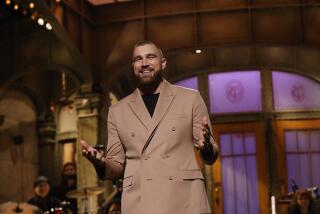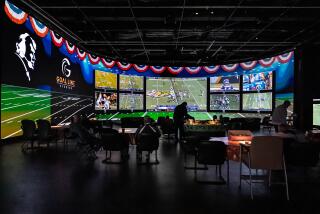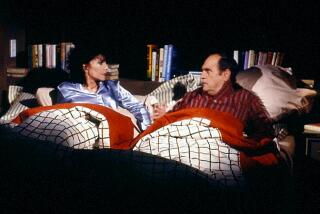A Bit of Broadway Comes to Canton : Namath Is Rewarded for Old Career, Begins a New One
CANTON, Ohio — Nearly everything was a little different Saturday at pro football’s Hall of Fame.
The weather was unusually cool and comfortable for August. The crowds for all functions were the biggest in history. More women were present than ever. And, possibly explaining the above, Joe Namath was here.
On the day of his Hall of Fame enshrinement--along with four others--Namath seemed to be mainly responsible for the unexpected surge of interest in the proceedings. Or so Canton officials believe.
“In terms of fan appeal, I’d say Joe is the most popular player we’ve had here,” Don Smith, a Hall of Fame executive, commented as most of Stark County turned out at noon for the induction ceremonies.
Eight summers after his last pro game, Namath, 42, remains the same magnetic, controversial figure New Yorkers knew as Broadway Joe 16 years ago when he quarterbacked the Jets to their upset win over Baltimore in Super Bowl III.
An unconventional, well-publicized anti-hero, he drew screams and sobs in those days wherever he appeared in public. And this week was like old times for Namath, who put a Hall of Fame exclamation point to one career and began another as a question mark at game-time Saturday afternoon.
As the New York Giants edged the Houston Oilers in the National Football League exhibition opener, 21-20, Namath became an ABC broadcaster replacing Don Meredith, or maybe it was Howard Cosell, or both, joining fellow Hall of Famers O.J. Simpson and Frank Gifford in the network’s new troika.
The public consensus on Namath’s manner on television, far removed from the fields he used to dominate as a long-ball passer, probably will form after a few more appearances.
But he made a faster start than many expected. At the network microphone, he was alert, knowledgeable and professional--more professional than most old pros working their first television game.
Last week at Canton, moreover, there were indications that Namath will carry many of his old fans with him to his new career.
Emerging into the sunlight one morning after breakfast with the mayor, Namath was surrounded by a crowd of yesterday’s loyal teenagers--now 16 years older--as he made his way through crowds of other autograph hunters and TV cameramen to his car. “Joe, Joe,” the women called, evoking memories of Jet games in the 60s.
They jammed in so close that for a while he couldn’t get into the car, a new silver and black Dodge convertible with license plates that read, simply, “Joe Namath.” Courtesy of the Hall of Fame, the machine was his for the week.
Along the street on both sides of him, the other 1985 enshrinees were heading for their convertibles at the same time. In the order of the way they had parked, they were Commissioner Pete Rozelle and three former All-Pros--center Frank Gatski, quarterback Roger Staubach and running back Simpson. And all walked along with no more than small groups of friends.
One person--his chauffeur--walked with Staubach.
Surveying the mob about Namath, a passer-by named Lou Holtz, the University of Minnesota coach and once the coach of the Jets, said:
“It used to be like that in New York. After the game, there were always 500 Jet fans waiting for Namath.”
You expect this of kids. But in Canton, it wasn’t just kids. At a Thursday night private party, a group of crusty Hall of Fame old-timers--Danny Fortmann, Mel Hein, Doug Atkins, Deacon Jones, Night Train Lane, Ray Nitschke, George McAfee and several others--showed what they think of the Namath mystique.
“He was the celebrity they looked up first,” Cleveland writer Chuck Heaton said. “Some of them didn’t even bother to look up some of the others.”
Namath has been a celebrity for 20 years. It was in 1965 that he signed his storied $400,000 contract to play football for the Jets.
“In 1965,” said Hall of Famer Hein, “$400,000 was like $4 million.”
Still living like a man who has parlayed 40 cents into $4 million, Namath made a fuss the day he arrived in Canton, declining to accept the suite he had been assigned at the headquarters hotel, the Parke.
“Only one of our suites is equipped with a Jacuzzi,” said innkeeper Bill McGladdery, “and we thought he’d like that, but he told us the rooms were too small.”
This left the hotel with two options. It has a larger, second-story suite overlooking the swimming pool, and it has a Presidential suite, which is the largest of all.
“When we showed Namath the one near the pool, he accepted right away,” McGladdery said. “And we all breathed a sigh of relief. You see, I already had Commissioner Rozelle in the Presidential suite.”
If there’d been a confrontation, it wouldn’t have been a Namath first.
When he was with the Jets, he was the only player in pro football who on road trips always lived in a suite. It was in his contract. Thus, on the night before an exhibition game one summer, Namath moved into the only suite of a small hotel in a small town. This meant that club owner Sonny Werblin would have to shift for himself in a standard double.
“You know this isn’t right, Joe,” Werblin screamed at him.
But Joe held his ground. “You signed the contract, sir,” he said.
Werblin recalled that his highest- priced performer said it mildly, politely and with a smile. He is almost always that way. For the most part, he was that way here. Heavily tanned, dark-haired, round-shouldered, Namath appeared to be the same relaxed, smiling character wherever he went.
The round shoulders, noticeable when he used to take the ball under center, are worse now, cutting his height from 6-2 to less than 6 feet. But otherwise, except for two bad knees, he was in good health after a summer in the sun in Florida and California.
He was accompanied to Canton by an entourage including a bodyguard, a secretary, his parents, and his wife, Deborah.
“We’re expecting our first son in October,” Joe said.
His parents are divorced. At their request, the Hall of Fame seated them at different tables morning, noon and night during the long series of banquets honoring Joe and the other members of the Canton class of ’85.
The class had been elected last January. The Hall of Fame committee, which includes a media representative from each NFL city, argued over Namath for three years, voting him down the first two times.
When it finally accepted him and the others at a meeting in San Francisco Super Bowl week, they were all immediately notified--all but Namath. After days of trying, the Canton people reached his agents, but never Namath.
Not until April did Namath finally call back to say he’d heard about it and would be here this week.
This helped enliven the arguments over Namath in Canton. Is he playboy or athlete? Does he really belong in the Hall of Fame?
Vito Stellino of Baltimore, president of the pro football writers, said: “Fifty years from today when people go over Joe’s numbers, they’ll note that in the only big game he ever played, his team only scored 16 points, and he passed for under 200 yards. And they’ll ask themselves: How did this guy ever get in?”
He got in, according to Hall of Fame quarterback Otto Graham, on merit.
Speaking as the longtime leader of the college team at the old Chicago All-Star game against the pros, Graham said: “Joe was the best quarterback I ever coached there.”
Holtz, head coach of the Jets in 1976, Namath’s last season with the team, said: “Joe was the greatest competitor on the club.”
As a pro, to be sure, Namath did play in only one big game. But if one game is enough to help a man into the Hall of Fame, this one qualifies. The Jets, an 18-point underdog in the 1969 Super Bowl, not only upset Baltimore, 16-7, but also made good after Namath had called it with the most famous prediction since Babe Ruth’s called home run in Chicago long ago.
So doing, Namath also made the American Football League respectable. And at the same time, after Green Bay had won the first two games for the other league, he made the Super Bowl what it is.
More than that, as Hall of Fame coach Sid Gillman said, Namath is a Hall of Famer on talent.
“Joe was the greatest passer of all time,” said Gillman, one of the nation’s leading authorities on pass offense. “His two patched-up knees kept him from proving it over a period of time--but he proved it long enough.”
Specifically, changing the science of passing with a new kind of delivery, Namath whipped the ball from behind his right ear, getting his power from a short, quick spin with his upper body. This supplanted the slower, classic, full-arm motion perfected by Sammy Baugh and Bob Waterfield.
What remains to be seen is whether Namath’s charismatic personality and knowledgeable approach to football are transferable to the TV screen.
He was more informative than charismatic in his ABC debut, and many fans thought that was a good thing.
They may have learned more football Saturday from him and Simpson, and from moderator Gifford, than ever before from a Monday night crew.
For example, Namath explained in detail two or three simple things--such as the rules requirement for 7 men, or 8, 9 or 10, on the offensive line.
This suggested that, as he said, it was indeed his wife who talked him into a TV audition after listening to his football chatter at home.
John Madden, it will be recalled, was an instant success. But Fran Tarkenton, who seemed similarly qualified, couldn’t stand the test of time.
So this was just a start for Namath. If the experience of his Canton week proves typical, however, he’ll be cheered along by a lot of fans.
More to Read
Go beyond the scoreboard
Get the latest on L.A.'s teams in the daily Sports Report newsletter.
You may occasionally receive promotional content from the Los Angeles Times.










